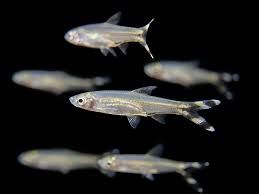Black Scissortail Rasbora (Rasbora trilineata)
Black Scissortail Rasbora (Rasbora trilineata)
The Black Scissortail Rasbora (Rasbora trilineata), also known as the Scissortail Rasbora, is a beautiful and active species of freshwater fish. It’s well-known for its distinct black markings, especially the black stripe that runs across its body, and its long, elegant tail fin, which resembles a pair of scissors when spread. Native to Southeast Asia, particularly Thailand and Myanmar, it is a popular addition to community aquariums due to its peaceful nature and striking appearance.
1. Tank Size
-
Minimum tank size: A 20-gallon tank (76 liters) is recommended for a school of 6-8 Black Scissortail Rasboras. These fish are active and enjoy swimming, so they benefit from having ample space to move around.
-
It’s best to keep them in schools, as they are schooling fish. Keeping them in a group helps reduce stress and promotes natural behavior.
2. Water Conditions
-
Temperature: Black Scissortail Rasboras prefer tropical water temperatures, ranging from 75°F to 82°F (24°C to 28°C).
-
pH: They thrive in slightly acidic to neutral water, with a pH range of 6.0 to 7.5.
-
Hardness: Soft to moderately hard water is ideal, with a hardness range of 4-12 dGH.
-
Water Quality: These fish are sensitive to poor water conditions, so regular water changes (about 25% per week) are essential to maintain optimal water quality. They prefer well-oxygenated water, so a gentle filter with moderate water flow works best.
3. Diet
-
Black Scissortail Rasboras are omnivores, and their diet should consist of a mix of foods:
-
High-quality flakes or pellets designed for small fish.
-
Live or frozen foods, such as brine shrimp, daphnia, bloodworms, or microworms.
-
They will also graze on algae and plant matter in the tank, so a small amount of vegetable matter like spirulina can be added to their diet.
-
-
Feed them small amounts 2-3 times a day, and avoid overfeeding to prevent water quality issues.
4. Tank Setup
-
Substrate: A fine gravel or sand substrate works well for Black Scissortail Rasboras, making it easy to clean and not too harsh on their delicate fins.
-
Aquascaping: They enjoy tanks with plenty of plants and swimming space. Live plants such as Java Fern, Anubias, and Hornwort are excellent choices. Providing hiding places or moss in the tank allows them to feel secure.
-
Lighting: Moderate lighting is ideal for these fish. Bright lights are acceptable, but they appreciate some shaded areas that plants can provide.
-
Water Movement: Black Scissortail Rasboras prefer moderate water movement, so use a filter that provides gentle flow. Strong currents may cause stress to these delicate swimmers.
5. Tankmates
-
Black Scissortail Rasboras are peaceful and make excellent tankmates for other non-aggressive species.
-
Suitable companions include:
-
Small tetras (e.g., Neon Tetras, Ember Tetras), Rasboras, small catfish (like Corydoras), and small peaceful species like Ottocinclus or snails.
-
-
Avoid keeping them with large or aggressive fish (e.g., bettas, cichlids), which might bully or eat them.
-
Keeping them in a school of at least 6-8 will help reduce stress and promote natural behavior.
6. Breeding
-
Breeding Black Scissortail Rasboras in captivity is possible, but it requires specific conditions:
-
Set up a breeding tank with soft, slightly acidic water and fine-leaved plants like Java Moss where the female can lay her eggs.
-
Spawning: The male will court the female by chasing her and showing off his colors. After successful mating, the female lays eggs on plants or the substrate, and the male fertilizes them.
-
Incubation: The eggs will hatch in about 24-36 hours. The fry should be fed infusoria or liquid fry food until they grow large enough to consume crushed flakes or baby brine shrimp.
-
7. Health
-
These fish are generally hardy, but they can be susceptible to common freshwater diseases like Ich, fin rot, and velvet disease if the water quality is poor.
-
Monitor water parameters regularly to prevent stress caused by fluctuating water conditions.
-
Avoid overfeeding, as this can lead to water quality issues and contribute to stress or health problems.
-
If you notice signs of illness like loss of appetite, faded color, or swimming difficulties, isolate the affected fish and address the water quality or treat the disease promptly.
Interesting Fact:
The Black Scissortail Rasbora gets its name from its distinct tail, which has a scissor-like shape, especially when fully extended. This tail is not just for show; it provides the fish with an excellent ability to maneuver quickly and gracefully through the water. Males, in particular, are known for their vibrant coloration, especially during courtship, where they will display their bright, deep-red hues and distinct black markings to attract females. This species is often seen in schools in the wild, which not only helps them avoid predators but also creates a beautiful display of synchronized swimming.

